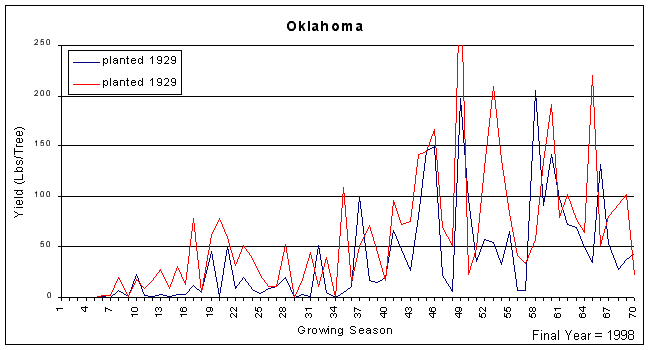Oklahoma

Average nut quality of test trees.
| # Nuts / lb. | % Kernel | Kernel quality breakdown | Specific gravity | ||
| % Fancy | % Standard | % Amber | |||
| 57 | 45% | 12% | 30% | 4% | .77 |
History
A native selection introduced in 1912 by O.K. Darden of Ardmore, OK. (Thompson and Young, 1985).
Comments
*Note: This is an older cultivar planted in the Old Variety Test at the Tifton Campus. Trees were planted decades ago when care was very different than it is now, and trees received much less care, so production data will reflect this fact. Trees began receiving insecticides in 1962, fungicides in 1970, nitrogen in 1962, and drip irrigation in 1975. The data for this cultivar was collected by several individuals, but the bulk of the data and the comments are from my predecessor Dr. Ray Worley. This information was originally published here: Worley and Mullinix, 1997.
This has never been a prominent cultivar, although it is better than several of the older cultivars. Nut size and kernel quality resemble those of 'Stuart'. Pistil receptivity is extremely late; it would need to be planted with a late pollen shedder. Its major redeeming characteristic is low spreading shape and interior bearing characteristic that should adapt it well to a pruning program. Yields have been good after modern cultural practices were started. It was among the top four to five yielders at age 55 through 65. OK for an old cultivar, but its time has come and past.
Production record of test trees beginning in year planted
'Oklahoma' production from the Old Variety Test. Each colored line represents the yearly production in pounds of nuts from an individual tree beginning the year planted.
Alternate Bearing Intensity* = .31
*Computed from mature trees using data from years after trees began fertilizer and pesticide sprays.

